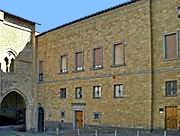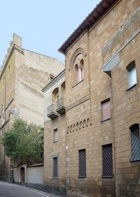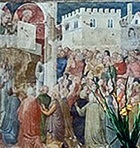


The present Palazzo Vescovile was built in 1956, at right angles to part of the Palazzi Papali to the left, on a site that has long been the centre of episcopal authority in Orvieto.

Early History
The first mention of a bishop of "Urbs Vetus" appears in a stern letter (ca. 590) from Pope Gregory I to Bishop Giovanni. The location of his palace is unknown.
The first palace on this location was probably built in the 11th century. Bishop Riccardo built a replacement in 1178 and Bishop Matteo consecrated its chapel, the Cappella di San Silvestro, in 1212.
A series of popes seem to have stayed here when they visited the city. When these visits became more frequent and prolonged in the later part of the 13th century, the complex was extended by the construction of a series of new papal palaces (the Palazzi Papali mentioned above). Pope Urban IV, who resided in Orvieto from October 1262 until September 1264, is documented as staying in Palazzo Vescovile in 1262. He seems to have begun the first of the adjoining the Palazzi Papali at this time.

The bishops of Orvieto probably used the whole complex (i.e. all of the papal palaces as well as Palazzo Vescovile) from the 14th century, when Orvieto ceased to be used as a papal residence.
When Palazzo Comunale became unfit for use in ca. 1485, the Commune held its meetings here, a practice that continued until 1580.

